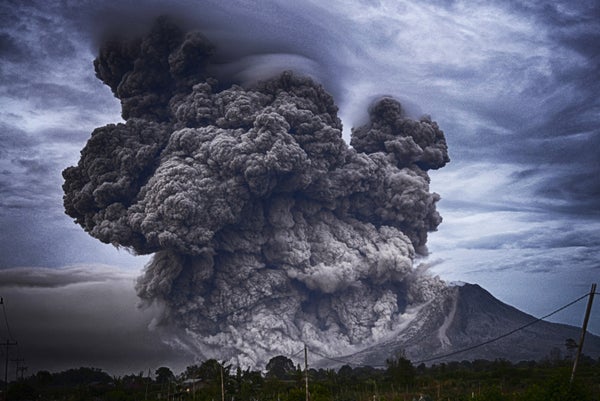Tens of thousands of people have evacuated their land in Bali as the nearby volcano Mount Agung angrily spits ash and its magma rises. Many Balinese hold the mountain sacred and accept its occasional outbursts as moral admonishments whereas geologists consider this activity a routine part of Earth’s behavior. But scientists have found another force—climate change—affects the frequency of eruptions. Now a new study shows even relatively minor climate variations may have such an influence. If they are right, today’s global warming could mean more and bigger volcanic eruptions in the future.
Throughout its history Earth has gone through periods of massive natural climate change such as entering and leaving ice ages. Scientists have noted volcanic eruptions tended to increase as glaciers melted. In a recent study published in Geology researchers looked at smaller-scale changes in glacial coverage to see if these incremental differences had any effect.
The scientists focused on eruptions in Iceland about 5,500 to 4,500 years ago. During that period Earth’s climate cooled and glaciers grew, but there was no full-blown ice age. To reconstruct a timeline of volcanic activity, the researchers examined the Icelandic eruption record as well as a record of the ash that fell in Europe during those Icelandic eruptions, which ultimately settled into microscopic layers in the continent’s peat bogs and lakes, study author Graeme Swindles says. He and his colleagues matched these layers to specific Icelandic volcanoes then developed a detailed timeline of increases and decreases in eruptions.
On supporting science journalism
If you're enjoying this article, consider supporting our award-winning journalism by subscribing. By purchasing a subscription you are helping to ensure the future of impactful stories about the discoveries and ideas shaping our world today.
When the scientists compared the volcanic record with glacial coverage, they found the number of eruptions indeed dropped significantly as the climate cooled and ice expanded. “There’s a big change in the record in the mid-Holocene [epoch], where we see no volcanic ash in Europe and very little in Iceland,” says Swindles, an associate professor of Earth system dynamics at the University of Leeds. “This seems to overlap with a time where there’s cold climate conditions, which would have favored glacial advance in Iceland.” He says his team observed an approximately 600-year lag between when glaciers advanced and volcanic activity diminished. “That’s because it takes a long time to grow ice masses,” he explains.
The new study is “looking at maybe the smallest-magnitude climate change yet to show it has influence on volcanic activity,” says Ben Edwards, an associate professor of geology at Dickinson College. “To see this change in an interglacial period indicates that there’s an even more subtle relationship between climate change and volcanism” than scientists previously thought. Julie Schindlbeck, a volcanologist at Heidelberg University in Germany, says the work shows “maybe even small changes in ice volume can really affect volcanism.”
Although scientists do not fully understand why glaciers appear to weaken volcanic eruptions,they believe the mechanics may be fairly straightforward. When glaciers expand, all that ice puts immense pressure on Earth’s surface. “It can affect magma flow and the voids and gaps in the Earth where magma flows to the surface as well as how much magma the crust can actually hold,” Swindles says. When glaciers retreat, the pressure lifts and volcanic activity surges. “After glaciers are removed the surface pressure decreases, and the magmas more easily propagate to the surface and thus erupt,” Swindles wrote in an e-mail to Scientific American.
This is exactly what he and his team found when they looked at what happened as Earth warmed up again and glaciers melted—they counted more eruptions. Again they saw a time lag, this time between ice melt and the rise in eruptions. But this gap was shorter. “It takes relatively less time to melt ice if the temperature goes up,” compared with growing ice when it gets colder, Swindles says. “So if you’re looking at a period of [warming and subsequent] volcanic flare-up, the lag might be a lot shorter.” He also notes that when volcanic eruptions occur during cooler, ice-covered times, they appear to be smaller in magnitude. As the climate warms, eruptions seem to get bigger.
Edwards notes Iceland’s unique geology makes it a very volcanically active compared with many other places, however—and also perhaps more vulnerable to the ice effect than other regions. “It’s probably a place that’s extra-sensitive to [glaciers growing and melting],” he says.
Whether this phenomenon will occur with modern-day climate change is not yet known. But Swindles says the glacier coverage changes his team studied are similar in magnitude to what Earth will likely experience due to human-influenced warming. “I think we can predict we’re probably going to see a lot more volcanic activity in areas of the world where glaciers and volcanoes interact,” he says, listing the U.S. Pacific Northwest, southern South America and even Antarctica. That, he says, is cause for grave concern—for businesses such as airlines as well as for general human and environmental health. “Volcanic ash and emissions can be deadly,” he says. “If not at least very damaging.”
